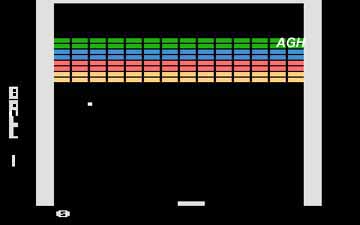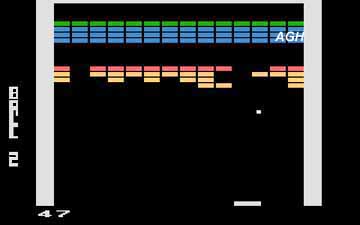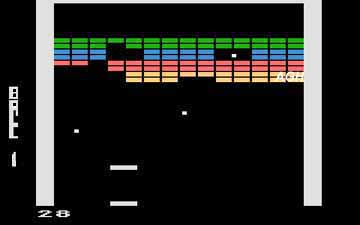|
Atari 5200 Review: SUPER BREAKOUT
by Atari
For most of the 5200's life, Super Breakout was the
game cartridge included with the purchase of the system. I always thought
this was a somewhat curious choice since it hardly represented the type
of capabilities that the SuperSystem possessed. A game that used the
higher resolution of the 5200 to better advantage might have prevented
Atari's next-generation machine from stumbling out of the blocks.
Oh well; now on to the game itself...
Super Breakout is the sequel to the legendary coin-op and 2600 ball-and-paddle
contest, and is an enhancement over its 2600 counterpart. It consists of
four game variations, including the original. In regular Breakout, the screen
consists of eight rows of 14 bricks each. Your objective is to clear the
screen of all the bricks by blasting them with a ball. Although aiming your
shot is paramount in succeeding in this game, it's equally as important just
to stay alive and keep the ball from getting by you (in which case you lose
a life.) In Progressive Breakout the playfield consists of four rows of
bricks at the top of the screen, followed by four blank rows, and then four
more rows of bricks. The point value is defined by color -- you get 1 point
for gold, 3 points for red, 5 for blue and 7 for for the green bricks. Once
game play begins, the brick walls slowly move down or "scroll" toward the
bottom of the screen. As bricks are knocked out and the walls progress toward
your paddle, new bricks enter the screen from the top at a progressively
faster rate (hence the name of this game mode.) As the walls progress
downward, their colors change and they are worth fewer points. In Double
Breakout, the screen is set-up the same as the original Breakout except there
are two paddles and two balls served each time. When both balls are in play,
each brick is worth twice its normal value, but it's tough to keep both balls
in play. However, the second paddle gives you a second chance with either one
or two balls, and most players will be able to achieve a higher rating than in
regular Breakout. On Cavity Breakout, the playfield contains two six-brick
cavities, each of which contains a ball. When the game begins, the balls
bounce inside each cavity but are held captive. There are two paddles as in
Double Breakout. The game is played normally until enough bricks are broken
to release a captive ball, and then, as in Double Breakout, bricks are worth
twice their point value while both balls are in play.
The first question you'll probably ask is how the game controls on the 5200
with its analog joystick instead of the usual potentiometer-based paddle
controller from the arcade and the 2600. Well, it takes some getting
used to. It's very difficult to quickly snap your paddle (the cursor on the
bottom of the screen) to its desired location since control is loose and
you also have to manually center the joystick to prevent it from veering
off in one direction. You'll also get a major inferiority complex by
playing 5200 Super Breakout. It's not that the game is any more difficult
than other versions, because it's not. But the scoring system is bound
to frustrate even the most seasoned player. Scores under 100 get you an
"Oops" rating, while scores between 200 and 300 is considered "Average" and
200-300 are "Good", and so on. It took me more than 20 plays to get a
"Good" rating, and that was only because of what I feel was divine intervention
of some sort. I found it curious that Atari did not include the children's
version found on the 2600 cartridge (no ball speedup and paddle does not
go to half size after the ball hits the top of the screen.)
The bottom line is that the 5200 edition of the classic ball-breaking
contenst doesn't quite measure up to versions found in the arcade
and 2600. There's really no substitute for the paddle control, and
even non-purists will find it too much of a frustrating experience to
give the game more than a few plays.
|
Title |
Super Breakout |
|
Publisher |
Atari |
|
System |
Atari 5200 SuperSystem |
|
Graphics |
3 |
|
Sound |
2 |
|
Gameplay |
4 |
|
Overall |
4 |
|
Reviewer |
Keita Iida |
|



